Contrasting Project Negotiation: Government vs Commercial Contracts
VerifiedAdded on 2023/06/11
|9
|2183
|329
Presentation
AI Summary
This presentation provides a comparative analysis of contract negotiation in government and non-government sectors, using the Channel Tunnel Project and the Queensland Health Project as case studies. It highlights the differences in contractual arrangements, stakeholder influence, conflict management, and negotiation methods. Government contracts often prioritize the government's benefits with limited negotiation scope for contractors, while commercial contracts involve mutual agreement and balanced benefits for both parties. The analysis covers diverse contractual arrangements, stakeholder conflict agendas, and methods of project negotiation, emphasizing the varying priorities and power dynamics in each sector. The presentation concludes that government contracts favor long-term governmental benefits, whereas commercial contracts aim for medium and short-term advantages for all parties involved. Desklib is a great platform to find similar solved assignments and resources.
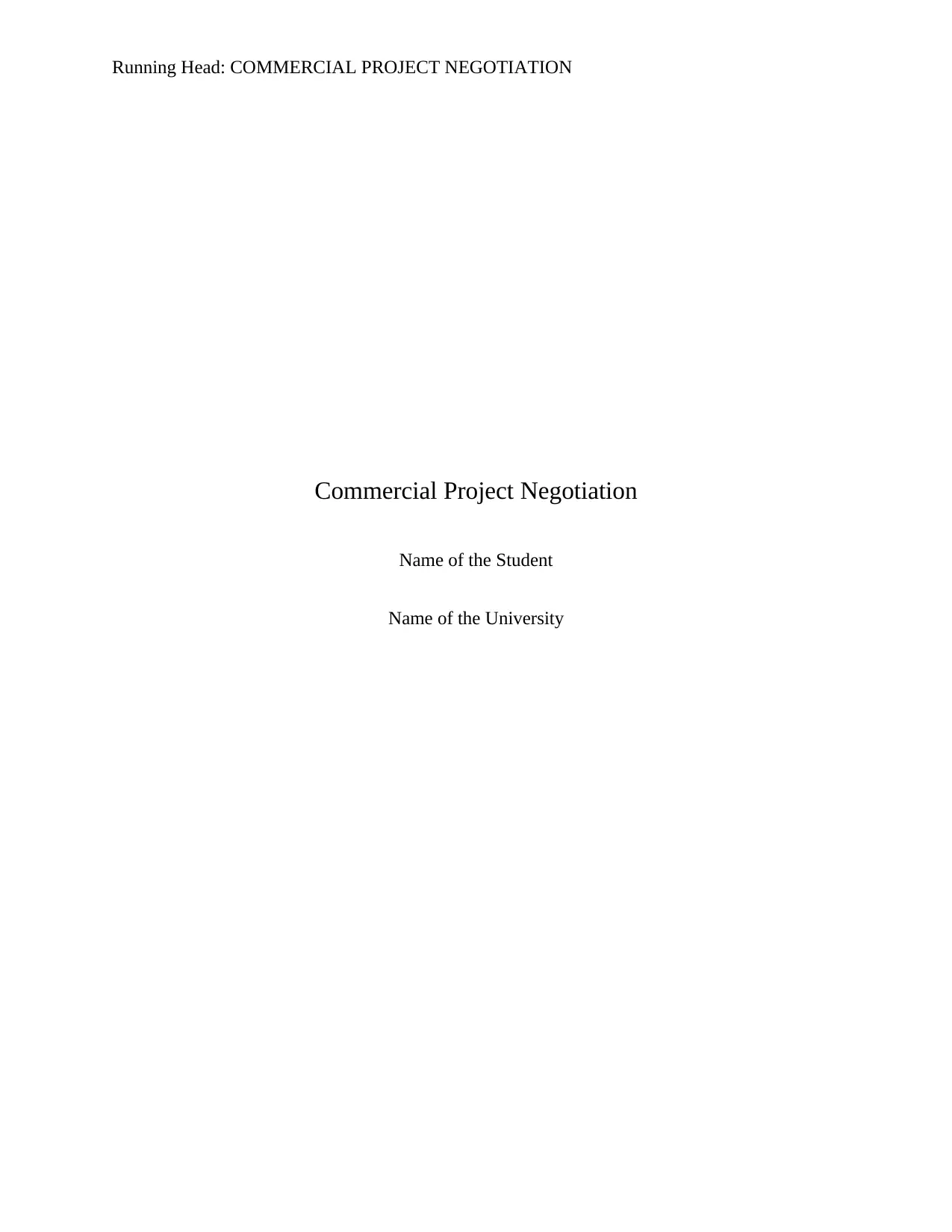
Running Head: COMMERCIAL PROJECT NEGOTIATION
Commercial Project Negotiation
Name of the Student
Name of the University
Commercial Project Negotiation
Name of the Student
Name of the University
Paraphrase This Document
Need a fresh take? Get an instant paraphrase of this document with our AI Paraphraser
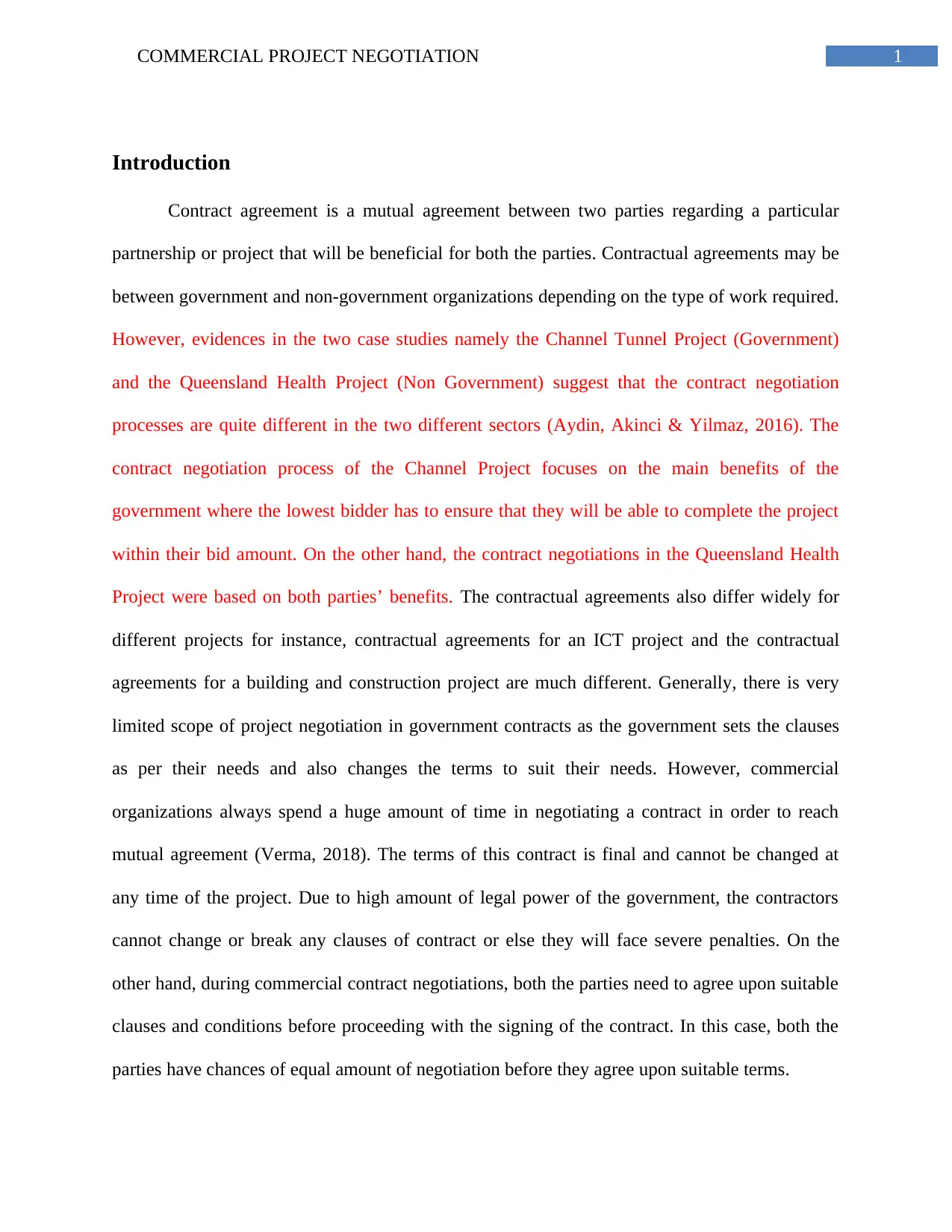
1COMMERCIAL PROJECT NEGOTIATION
Introduction
Contract agreement is a mutual agreement between two parties regarding a particular
partnership or project that will be beneficial for both the parties. Contractual agreements may be
between government and non-government organizations depending on the type of work required.
However, evidences in the two case studies namely the Channel Tunnel Project (Government)
and the Queensland Health Project (Non Government) suggest that the contract negotiation
processes are quite different in the two different sectors (Aydin, Akinci & Yilmaz, 2016). The
contract negotiation process of the Channel Project focuses on the main benefits of the
government where the lowest bidder has to ensure that they will be able to complete the project
within their bid amount. On the other hand, the contract negotiations in the Queensland Health
Project were based on both parties’ benefits. The contractual agreements also differ widely for
different projects for instance, contractual agreements for an ICT project and the contractual
agreements for a building and construction project are much different. Generally, there is very
limited scope of project negotiation in government contracts as the government sets the clauses
as per their needs and also changes the terms to suit their needs. However, commercial
organizations always spend a huge amount of time in negotiating a contract in order to reach
mutual agreement (Verma, 2018). The terms of this contract is final and cannot be changed at
any time of the project. Due to high amount of legal power of the government, the contractors
cannot change or break any clauses of contract or else they will face severe penalties. On the
other hand, during commercial contract negotiations, both the parties need to agree upon suitable
clauses and conditions before proceeding with the signing of the contract. In this case, both the
parties have chances of equal amount of negotiation before they agree upon suitable terms.
Introduction
Contract agreement is a mutual agreement between two parties regarding a particular
partnership or project that will be beneficial for both the parties. Contractual agreements may be
between government and non-government organizations depending on the type of work required.
However, evidences in the two case studies namely the Channel Tunnel Project (Government)
and the Queensland Health Project (Non Government) suggest that the contract negotiation
processes are quite different in the two different sectors (Aydin, Akinci & Yilmaz, 2016). The
contract negotiation process of the Channel Project focuses on the main benefits of the
government where the lowest bidder has to ensure that they will be able to complete the project
within their bid amount. On the other hand, the contract negotiations in the Queensland Health
Project were based on both parties’ benefits. The contractual agreements also differ widely for
different projects for instance, contractual agreements for an ICT project and the contractual
agreements for a building and construction project are much different. Generally, there is very
limited scope of project negotiation in government contracts as the government sets the clauses
as per their needs and also changes the terms to suit their needs. However, commercial
organizations always spend a huge amount of time in negotiating a contract in order to reach
mutual agreement (Verma, 2018). The terms of this contract is final and cannot be changed at
any time of the project. Due to high amount of legal power of the government, the contractors
cannot change or break any clauses of contract or else they will face severe penalties. On the
other hand, during commercial contract negotiations, both the parties need to agree upon suitable
clauses and conditions before proceeding with the signing of the contract. In this case, both the
parties have chances of equal amount of negotiation before they agree upon suitable terms.
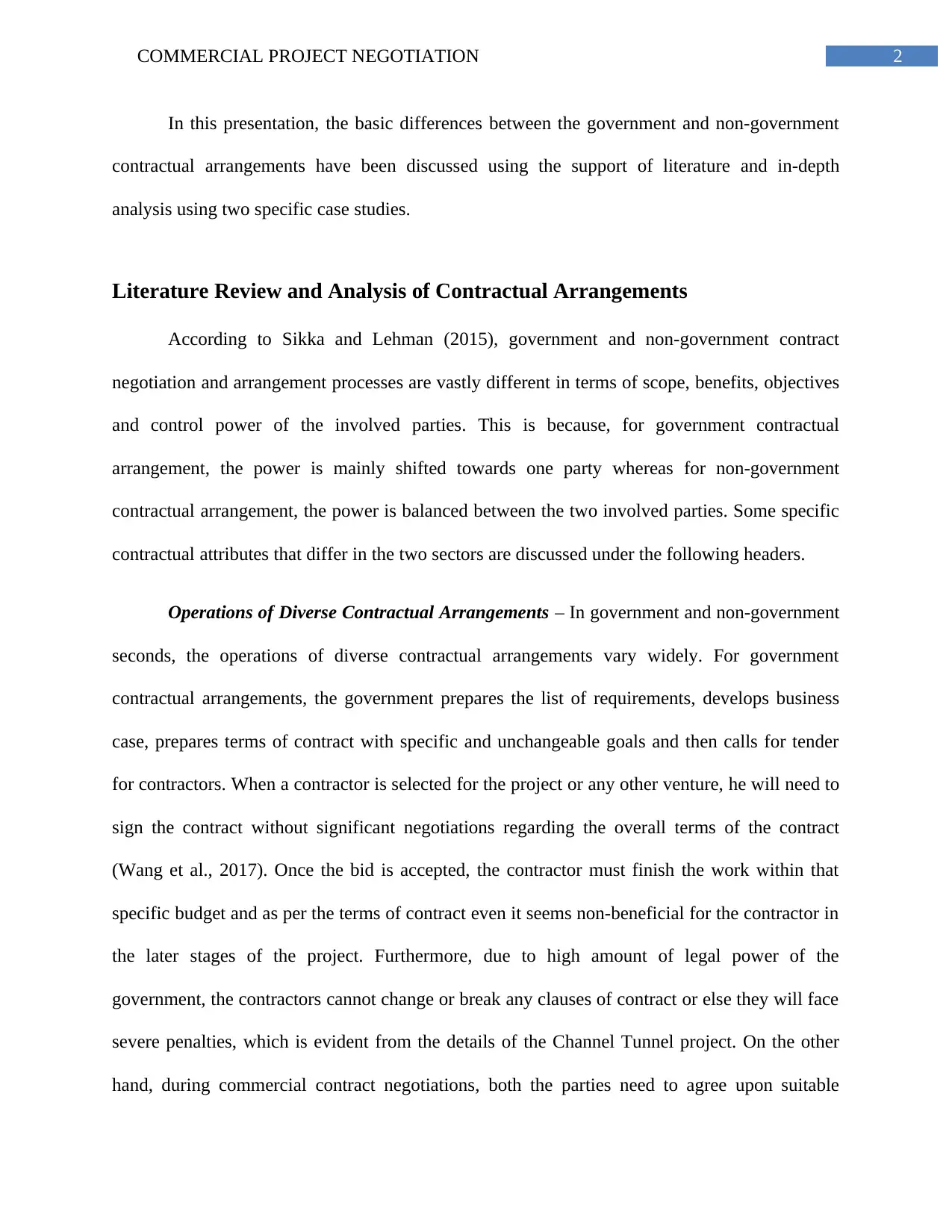
2COMMERCIAL PROJECT NEGOTIATION
In this presentation, the basic differences between the government and non-government
contractual arrangements have been discussed using the support of literature and in-depth
analysis using two specific case studies.
Literature Review and Analysis of Contractual Arrangements
According to Sikka and Lehman (2015), government and non-government contract
negotiation and arrangement processes are vastly different in terms of scope, benefits, objectives
and control power of the involved parties. This is because, for government contractual
arrangement, the power is mainly shifted towards one party whereas for non-government
contractual arrangement, the power is balanced between the two involved parties. Some specific
contractual attributes that differ in the two sectors are discussed under the following headers.
Operations of Diverse Contractual Arrangements – In government and non-government
seconds, the operations of diverse contractual arrangements vary widely. For government
contractual arrangements, the government prepares the list of requirements, develops business
case, prepares terms of contract with specific and unchangeable goals and then calls for tender
for contractors. When a contractor is selected for the project or any other venture, he will need to
sign the contract without significant negotiations regarding the overall terms of the contract
(Wang et al., 2017). Once the bid is accepted, the contractor must finish the work within that
specific budget and as per the terms of contract even it seems non-beneficial for the contractor in
the later stages of the project. Furthermore, due to high amount of legal power of the
government, the contractors cannot change or break any clauses of contract or else they will face
severe penalties, which is evident from the details of the Channel Tunnel project. On the other
hand, during commercial contract negotiations, both the parties need to agree upon suitable
In this presentation, the basic differences between the government and non-government
contractual arrangements have been discussed using the support of literature and in-depth
analysis using two specific case studies.
Literature Review and Analysis of Contractual Arrangements
According to Sikka and Lehman (2015), government and non-government contract
negotiation and arrangement processes are vastly different in terms of scope, benefits, objectives
and control power of the involved parties. This is because, for government contractual
arrangement, the power is mainly shifted towards one party whereas for non-government
contractual arrangement, the power is balanced between the two involved parties. Some specific
contractual attributes that differ in the two sectors are discussed under the following headers.
Operations of Diverse Contractual Arrangements – In government and non-government
seconds, the operations of diverse contractual arrangements vary widely. For government
contractual arrangements, the government prepares the list of requirements, develops business
case, prepares terms of contract with specific and unchangeable goals and then calls for tender
for contractors. When a contractor is selected for the project or any other venture, he will need to
sign the contract without significant negotiations regarding the overall terms of the contract
(Wang et al., 2017). Once the bid is accepted, the contractor must finish the work within that
specific budget and as per the terms of contract even it seems non-beneficial for the contractor in
the later stages of the project. Furthermore, due to high amount of legal power of the
government, the contractors cannot change or break any clauses of contract or else they will face
severe penalties, which is evident from the details of the Channel Tunnel project. On the other
hand, during commercial contract negotiations, both the parties need to agree upon suitable
⊘ This is a preview!⊘
Do you want full access?
Subscribe today to unlock all pages.

Trusted by 1+ million students worldwide
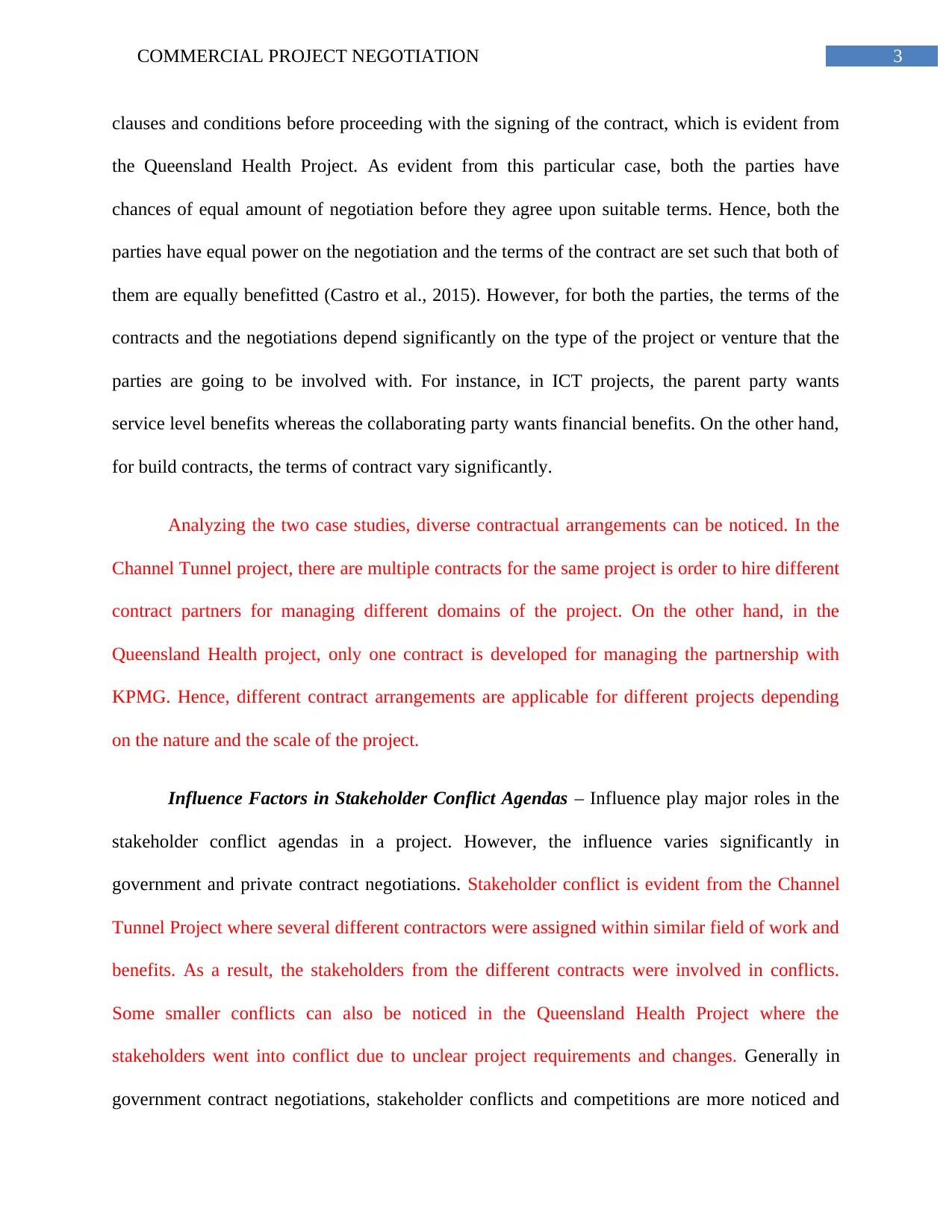
3COMMERCIAL PROJECT NEGOTIATION
clauses and conditions before proceeding with the signing of the contract, which is evident from
the Queensland Health Project. As evident from this particular case, both the parties have
chances of equal amount of negotiation before they agree upon suitable terms. Hence, both the
parties have equal power on the negotiation and the terms of the contract are set such that both of
them are equally benefitted (Castro et al., 2015). However, for both the parties, the terms of the
contracts and the negotiations depend significantly on the type of the project or venture that the
parties are going to be involved with. For instance, in ICT projects, the parent party wants
service level benefits whereas the collaborating party wants financial benefits. On the other hand,
for build contracts, the terms of contract vary significantly.
Analyzing the two case studies, diverse contractual arrangements can be noticed. In the
Channel Tunnel project, there are multiple contracts for the same project is order to hire different
contract partners for managing different domains of the project. On the other hand, in the
Queensland Health project, only one contract is developed for managing the partnership with
KPMG. Hence, different contract arrangements are applicable for different projects depending
on the nature and the scale of the project.
Influence Factors in Stakeholder Conflict Agendas – Influence play major roles in the
stakeholder conflict agendas in a project. However, the influence varies significantly in
government and private contract negotiations. Stakeholder conflict is evident from the Channel
Tunnel Project where several different contractors were assigned within similar field of work and
benefits. As a result, the stakeholders from the different contracts were involved in conflicts.
Some smaller conflicts can also be noticed in the Queensland Health Project where the
stakeholders went into conflict due to unclear project requirements and changes. Generally in
government contract negotiations, stakeholder conflicts and competitions are more noticed and
clauses and conditions before proceeding with the signing of the contract, which is evident from
the Queensland Health Project. As evident from this particular case, both the parties have
chances of equal amount of negotiation before they agree upon suitable terms. Hence, both the
parties have equal power on the negotiation and the terms of the contract are set such that both of
them are equally benefitted (Castro et al., 2015). However, for both the parties, the terms of the
contracts and the negotiations depend significantly on the type of the project or venture that the
parties are going to be involved with. For instance, in ICT projects, the parent party wants
service level benefits whereas the collaborating party wants financial benefits. On the other hand,
for build contracts, the terms of contract vary significantly.
Analyzing the two case studies, diverse contractual arrangements can be noticed. In the
Channel Tunnel project, there are multiple contracts for the same project is order to hire different
contract partners for managing different domains of the project. On the other hand, in the
Queensland Health project, only one contract is developed for managing the partnership with
KPMG. Hence, different contract arrangements are applicable for different projects depending
on the nature and the scale of the project.
Influence Factors in Stakeholder Conflict Agendas – Influence play major roles in the
stakeholder conflict agendas in a project. However, the influence varies significantly in
government and private contract negotiations. Stakeholder conflict is evident from the Channel
Tunnel Project where several different contractors were assigned within similar field of work and
benefits. As a result, the stakeholders from the different contracts were involved in conflicts.
Some smaller conflicts can also be noticed in the Queensland Health Project where the
stakeholders went into conflict due to unclear project requirements and changes. Generally in
government contract negotiations, stakeholder conflicts and competitions are more noticed and
Paraphrase This Document
Need a fresh take? Get an instant paraphrase of this document with our AI Paraphraser
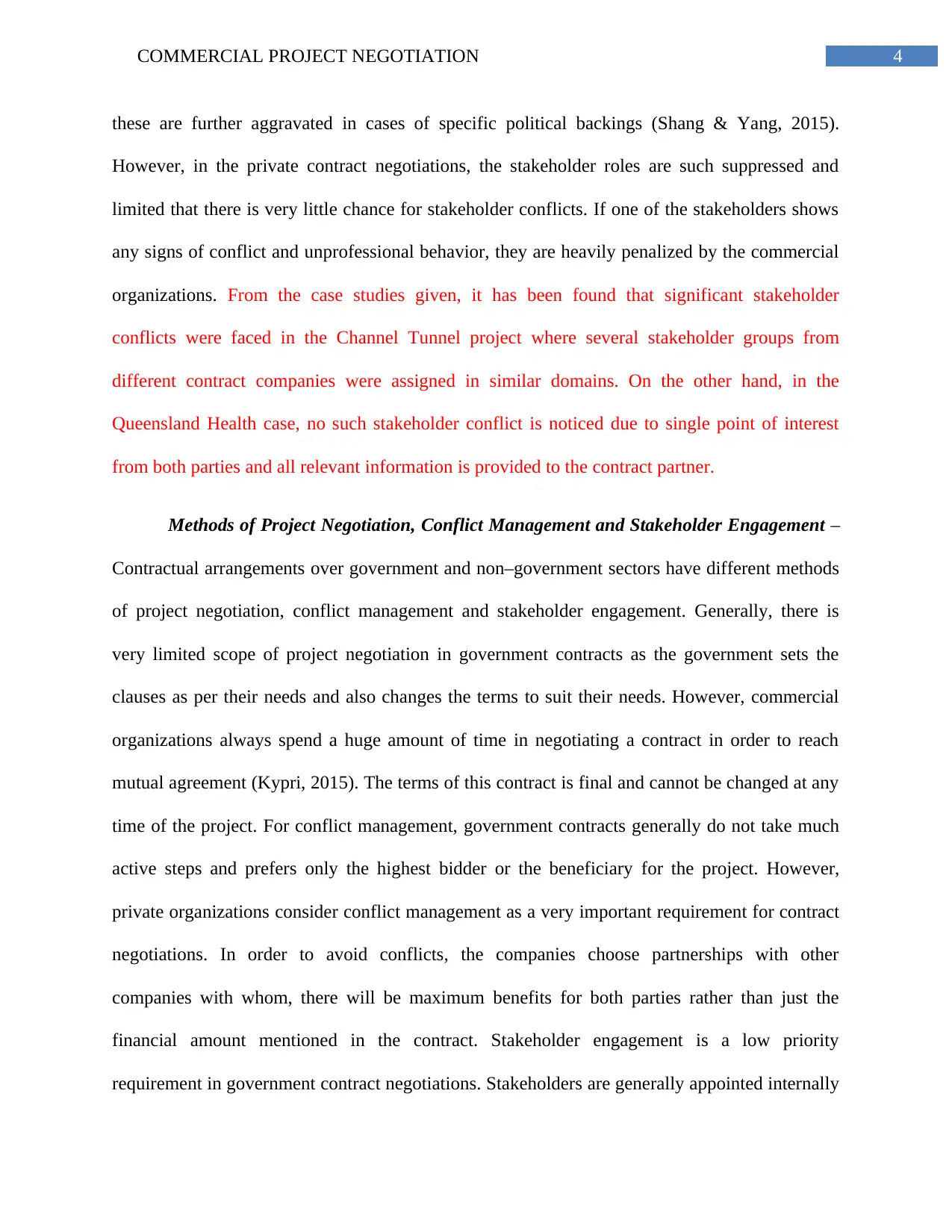
4COMMERCIAL PROJECT NEGOTIATION
these are further aggravated in cases of specific political backings (Shang & Yang, 2015).
However, in the private contract negotiations, the stakeholder roles are such suppressed and
limited that there is very little chance for stakeholder conflicts. If one of the stakeholders shows
any signs of conflict and unprofessional behavior, they are heavily penalized by the commercial
organizations. From the case studies given, it has been found that significant stakeholder
conflicts were faced in the Channel Tunnel project where several stakeholder groups from
different contract companies were assigned in similar domains. On the other hand, in the
Queensland Health case, no such stakeholder conflict is noticed due to single point of interest
from both parties and all relevant information is provided to the contract partner.
Methods of Project Negotiation, Conflict Management and Stakeholder Engagement –
Contractual arrangements over government and non–government sectors have different methods
of project negotiation, conflict management and stakeholder engagement. Generally, there is
very limited scope of project negotiation in government contracts as the government sets the
clauses as per their needs and also changes the terms to suit their needs. However, commercial
organizations always spend a huge amount of time in negotiating a contract in order to reach
mutual agreement (Kypri, 2015). The terms of this contract is final and cannot be changed at any
time of the project. For conflict management, government contracts generally do not take much
active steps and prefers only the highest bidder or the beneficiary for the project. However,
private organizations consider conflict management as a very important requirement for contract
negotiations. In order to avoid conflicts, the companies choose partnerships with other
companies with whom, there will be maximum benefits for both parties rather than just the
financial amount mentioned in the contract. Stakeholder engagement is a low priority
requirement in government contract negotiations. Stakeholders are generally appointed internally
these are further aggravated in cases of specific political backings (Shang & Yang, 2015).
However, in the private contract negotiations, the stakeholder roles are such suppressed and
limited that there is very little chance for stakeholder conflicts. If one of the stakeholders shows
any signs of conflict and unprofessional behavior, they are heavily penalized by the commercial
organizations. From the case studies given, it has been found that significant stakeholder
conflicts were faced in the Channel Tunnel project where several stakeholder groups from
different contract companies were assigned in similar domains. On the other hand, in the
Queensland Health case, no such stakeholder conflict is noticed due to single point of interest
from both parties and all relevant information is provided to the contract partner.
Methods of Project Negotiation, Conflict Management and Stakeholder Engagement –
Contractual arrangements over government and non–government sectors have different methods
of project negotiation, conflict management and stakeholder engagement. Generally, there is
very limited scope of project negotiation in government contracts as the government sets the
clauses as per their needs and also changes the terms to suit their needs. However, commercial
organizations always spend a huge amount of time in negotiating a contract in order to reach
mutual agreement (Kypri, 2015). The terms of this contract is final and cannot be changed at any
time of the project. For conflict management, government contracts generally do not take much
active steps and prefers only the highest bidder or the beneficiary for the project. However,
private organizations consider conflict management as a very important requirement for contract
negotiations. In order to avoid conflicts, the companies choose partnerships with other
companies with whom, there will be maximum benefits for both parties rather than just the
financial amount mentioned in the contract. Stakeholder engagement is a low priority
requirement in government contract negotiations. Stakeholders are generally appointed internally
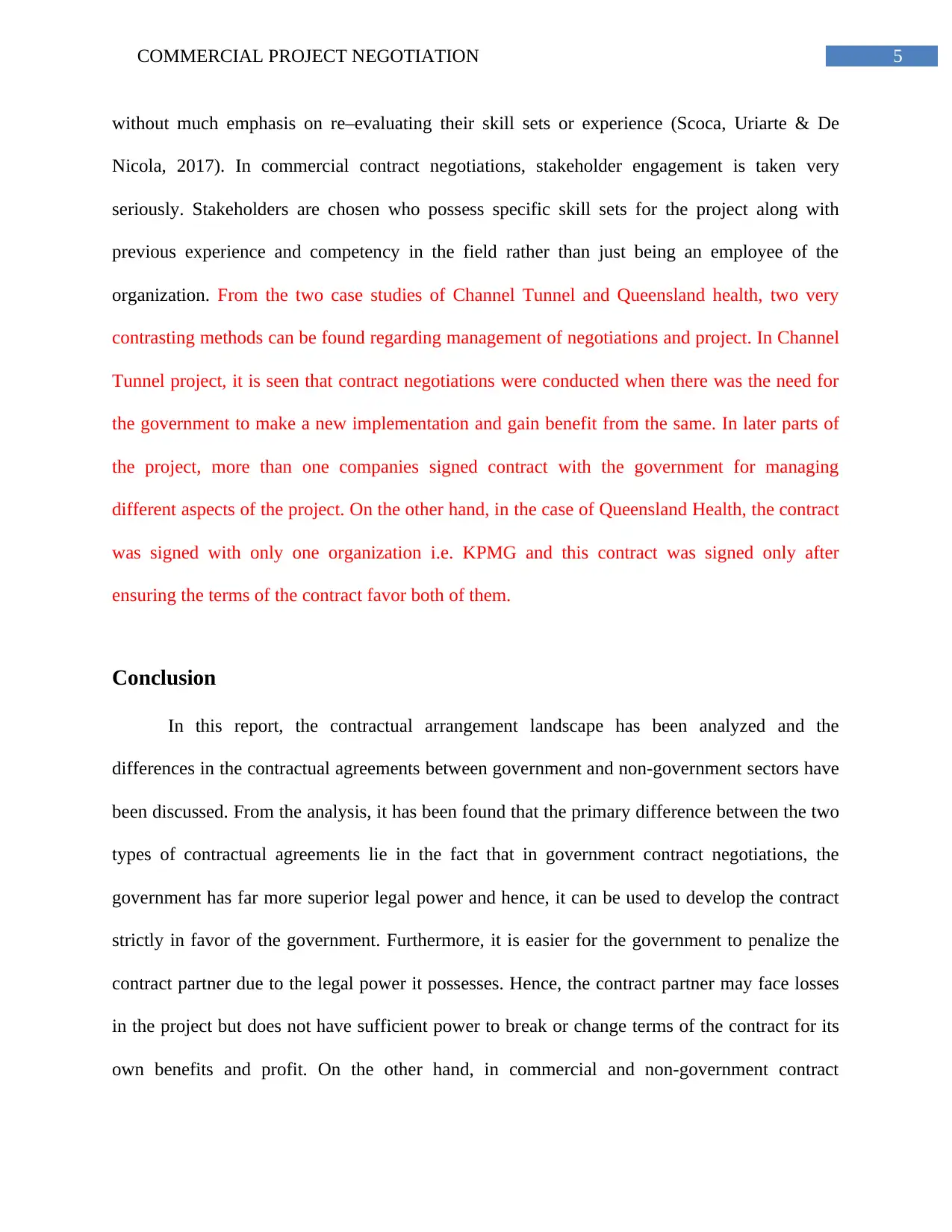
5COMMERCIAL PROJECT NEGOTIATION
without much emphasis on re–evaluating their skill sets or experience (Scoca, Uriarte & De
Nicola, 2017). In commercial contract negotiations, stakeholder engagement is taken very
seriously. Stakeholders are chosen who possess specific skill sets for the project along with
previous experience and competency in the field rather than just being an employee of the
organization. From the two case studies of Channel Tunnel and Queensland health, two very
contrasting methods can be found regarding management of negotiations and project. In Channel
Tunnel project, it is seen that contract negotiations were conducted when there was the need for
the government to make a new implementation and gain benefit from the same. In later parts of
the project, more than one companies signed contract with the government for managing
different aspects of the project. On the other hand, in the case of Queensland Health, the contract
was signed with only one organization i.e. KPMG and this contract was signed only after
ensuring the terms of the contract favor both of them.
Conclusion
In this report, the contractual arrangement landscape has been analyzed and the
differences in the contractual agreements between government and non-government sectors have
been discussed. From the analysis, it has been found that the primary difference between the two
types of contractual agreements lie in the fact that in government contract negotiations, the
government has far more superior legal power and hence, it can be used to develop the contract
strictly in favor of the government. Furthermore, it is easier for the government to penalize the
contract partner due to the legal power it possesses. Hence, the contract partner may face losses
in the project but does not have sufficient power to break or change terms of the contract for its
own benefits and profit. On the other hand, in commercial and non-government contract
without much emphasis on re–evaluating their skill sets or experience (Scoca, Uriarte & De
Nicola, 2017). In commercial contract negotiations, stakeholder engagement is taken very
seriously. Stakeholders are chosen who possess specific skill sets for the project along with
previous experience and competency in the field rather than just being an employee of the
organization. From the two case studies of Channel Tunnel and Queensland health, two very
contrasting methods can be found regarding management of negotiations and project. In Channel
Tunnel project, it is seen that contract negotiations were conducted when there was the need for
the government to make a new implementation and gain benefit from the same. In later parts of
the project, more than one companies signed contract with the government for managing
different aspects of the project. On the other hand, in the case of Queensland Health, the contract
was signed with only one organization i.e. KPMG and this contract was signed only after
ensuring the terms of the contract favor both of them.
Conclusion
In this report, the contractual arrangement landscape has been analyzed and the
differences in the contractual agreements between government and non-government sectors have
been discussed. From the analysis, it has been found that the primary difference between the two
types of contractual agreements lie in the fact that in government contract negotiations, the
government has far more superior legal power and hence, it can be used to develop the contract
strictly in favor of the government. Furthermore, it is easier for the government to penalize the
contract partner due to the legal power it possesses. Hence, the contract partner may face losses
in the project but does not have sufficient power to break or change terms of the contract for its
own benefits and profit. On the other hand, in commercial and non-government contract
⊘ This is a preview!⊘
Do you want full access?
Subscribe today to unlock all pages.

Trusted by 1+ million students worldwide
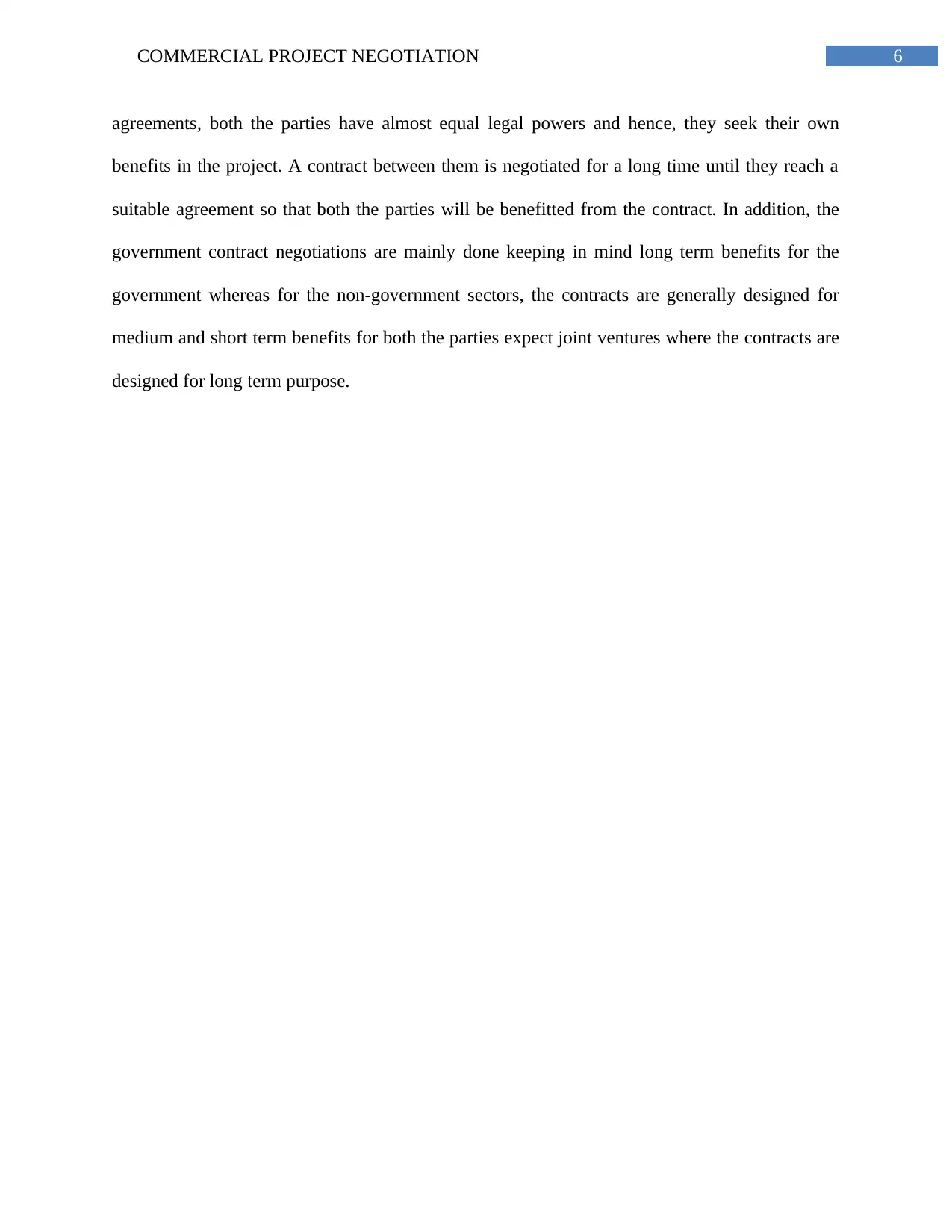
6COMMERCIAL PROJECT NEGOTIATION
agreements, both the parties have almost equal legal powers and hence, they seek their own
benefits in the project. A contract between them is negotiated for a long time until they reach a
suitable agreement so that both the parties will be benefitted from the contract. In addition, the
government contract negotiations are mainly done keeping in mind long term benefits for the
government whereas for the non-government sectors, the contracts are generally designed for
medium and short term benefits for both the parties expect joint ventures where the contracts are
designed for long term purpose.
agreements, both the parties have almost equal legal powers and hence, they seek their own
benefits in the project. A contract between them is negotiated for a long time until they reach a
suitable agreement so that both the parties will be benefitted from the contract. In addition, the
government contract negotiations are mainly done keeping in mind long term benefits for the
government whereas for the non-government sectors, the contracts are generally designed for
medium and short term benefits for both the parties expect joint ventures where the contracts are
designed for long term purpose.
Paraphrase This Document
Need a fresh take? Get an instant paraphrase of this document with our AI Paraphraser

7COMMERCIAL PROJECT NEGOTIATION
References
Aydin, C., Akinci, M., & Yilmaz, Ö. (2016). The Analysis of Visible Hand of Government: The
Threshold Effect of Government Spending on Economic Growth. International Journal
of Trade, Economics and Finance, 7(5), 170.
Castro, I., Panda, A., Raghavan, B., Shenker, S., & Gorinsky, S. (2015). Route bazaar: automatic
interdomain contract negotiation.
Demirag, I. (2017). A framework for examining accountability and value for money in the UK’s
private finance initiative. In Corporate Social Responsibility, Accountability and
Governance (pp. 77-92). Routledge.
Kypri, K. (2015). Suppression clauses in university health research: Case study of an Australian
government contract negotiation. The Medical Journal of Australia, 203(2), 72-74.
Scoca, V., Uriarte, R. B., & De Nicola, R. (2017, June). Smart Contract Negotiation in Cloud
Computing. In Cloud Computing (CLOUD), 2017 IEEE 10th International Conference
on (pp. 592-599). IEEE.
Shang, W., & Yang, L. (2015). Contract negotiation and risk preferences in dual-channel supply
chain coordination. International Journal of Production Research, 53(16), 4837-4856.
Sikka, P., & Lehman, G. (2015). The supply-side of corruption and limits to preventing
corruption within government procurement and constructing ethical subjects. Critical
Perspectives on Accounting, 28, 62-70.
References
Aydin, C., Akinci, M., & Yilmaz, Ö. (2016). The Analysis of Visible Hand of Government: The
Threshold Effect of Government Spending on Economic Growth. International Journal
of Trade, Economics and Finance, 7(5), 170.
Castro, I., Panda, A., Raghavan, B., Shenker, S., & Gorinsky, S. (2015). Route bazaar: automatic
interdomain contract negotiation.
Demirag, I. (2017). A framework for examining accountability and value for money in the UK’s
private finance initiative. In Corporate Social Responsibility, Accountability and
Governance (pp. 77-92). Routledge.
Kypri, K. (2015). Suppression clauses in university health research: Case study of an Australian
government contract negotiation. The Medical Journal of Australia, 203(2), 72-74.
Scoca, V., Uriarte, R. B., & De Nicola, R. (2017, June). Smart Contract Negotiation in Cloud
Computing. In Cloud Computing (CLOUD), 2017 IEEE 10th International Conference
on (pp. 592-599). IEEE.
Shang, W., & Yang, L. (2015). Contract negotiation and risk preferences in dual-channel supply
chain coordination. International Journal of Production Research, 53(16), 4837-4856.
Sikka, P., & Lehman, G. (2015). The supply-side of corruption and limits to preventing
corruption within government procurement and constructing ethical subjects. Critical
Perspectives on Accounting, 28, 62-70.
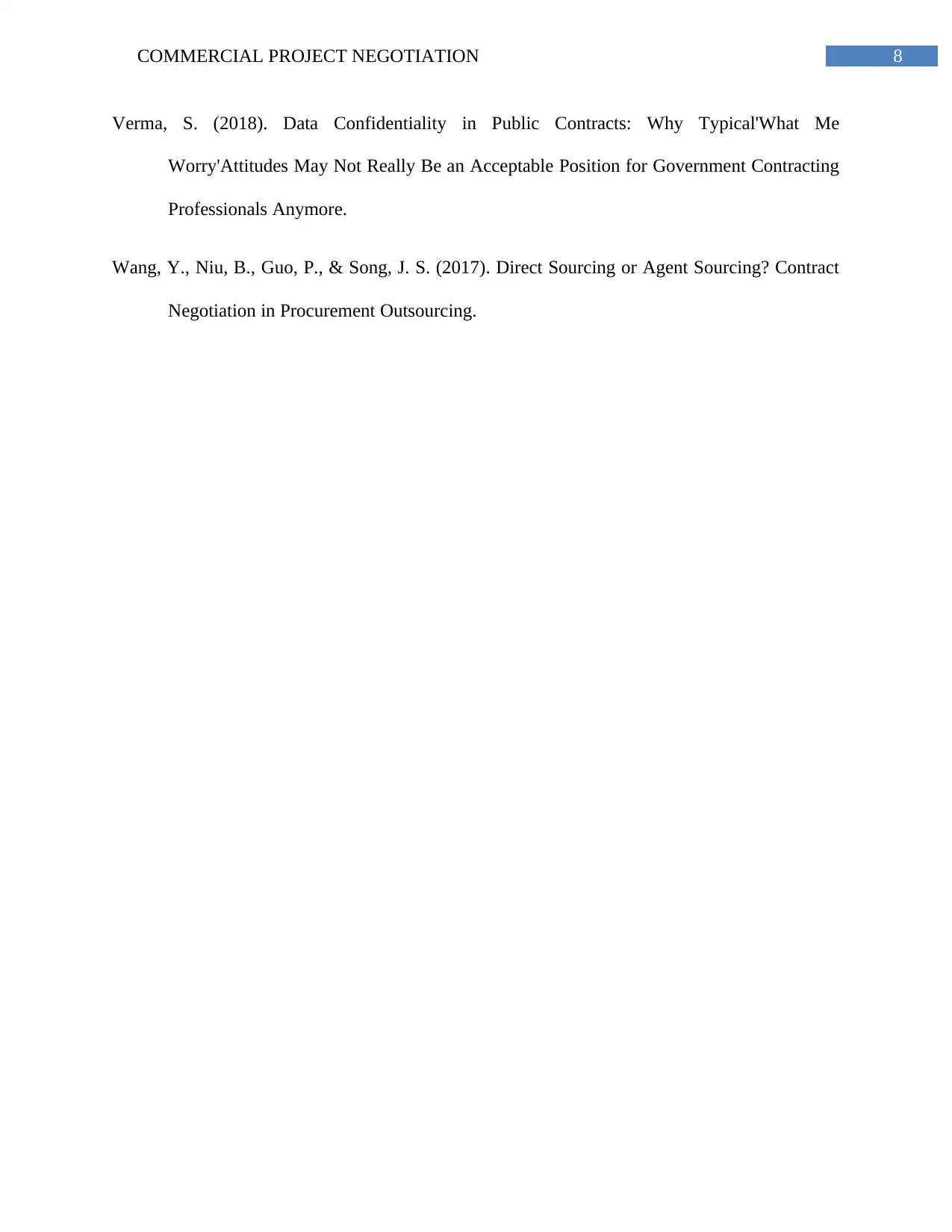
8COMMERCIAL PROJECT NEGOTIATION
Verma, S. (2018). Data Confidentiality in Public Contracts: Why Typical'What Me
Worry'Attitudes May Not Really Be an Acceptable Position for Government Contracting
Professionals Anymore.
Wang, Y., Niu, B., Guo, P., & Song, J. S. (2017). Direct Sourcing or Agent Sourcing? Contract
Negotiation in Procurement Outsourcing.
Verma, S. (2018). Data Confidentiality in Public Contracts: Why Typical'What Me
Worry'Attitudes May Not Really Be an Acceptable Position for Government Contracting
Professionals Anymore.
Wang, Y., Niu, B., Guo, P., & Song, J. S. (2017). Direct Sourcing or Agent Sourcing? Contract
Negotiation in Procurement Outsourcing.
⊘ This is a preview!⊘
Do you want full access?
Subscribe today to unlock all pages.

Trusted by 1+ million students worldwide
1 out of 9
Related Documents
Your All-in-One AI-Powered Toolkit for Academic Success.
+13062052269
info@desklib.com
Available 24*7 on WhatsApp / Email
![[object Object]](/_next/static/media/star-bottom.7253800d.svg)
Unlock your academic potential
Copyright © 2020–2025 A2Z Services. All Rights Reserved. Developed and managed by ZUCOL.




